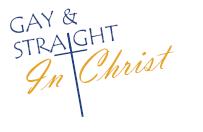 A Christian-based fellowship group for LGBT persons, their families, and friends
A Christian-based fellowship group for LGBT persons, their families, and friends
Gay and Straight in Christ welcomes, supports, and affirms LGBT (lesbian, gay, bisexual, and transgender) persons, their families and friends and those who wish to stand in solidarity with them in Christ. This ministry works to help the LGBTQ+ community find comfort in taking its rightful place within the Catholic community.
We will strive to provide:
- The message that our church is open to all persons as a welcoming and affirming Christian community. We affirm the love of Christ for everyone and offer a place of worship for any who may have felt unwelcome or disenfranchised in the Catholic faith. God does not discriminate. We choose to do the same.
- A safe environment where ideas can be exchanged without fear or judgment. As gay and straight Disciples of Christ, we share our unique gifts and perspectives openly. All are held in confidence.
- Support for those coming out or struggling with someone else’s coming out. We provide encouragement and spiritual resources with a modern Christian perspective.
- Education for all as we worship, learn and grow together in Christian faith.
- Faith sharing by exploring what the Bible says regarding homosexuality and what it does not say. We reflect on the Bible within the context and culture in which it was written.
- Outreach to the LGBTQ+ community, their family members and friends. We endeavor to help LGBTQ+ people be an integral part of the Catholic Christian community. We believe that God’s love is inclusive and unconditional and we pride ourselves in our demonstration of that love.
What is the History of this Ministry?
- GASIC began in the early 2000s at Good Shepherd in Menomonee Falls.
- St. Mary’s in Hales Corners initiated this ministry about 2010.
- We occasionally collaborate with these two parishes for “larger events” such as movie nights, speakers, or community events.
GASIC 2024/2025 Calendar
All meetings take place from 7:00 pm–8:30 pm via Zoom unless otherwise noted. Meetings consist of prayer opportunities, discussion, and occasional guest presenters.
- September 11
- October 9
- November 13
- December 11
- January 8
- February 12
- March 12
- April 9
- May 14
- June 11
All are welcome!
How do I get involved?
If you are interested in joining us or know of someone who would benefit from this group, please come to any meeting!
For more information or link to the Zoom meetings, kindly contact the Parish Office.
CONFIDENTIALITY STATEMENT
This support group is committed to maintaining confidentiality. Every individual attending any meeting is assured that their stories and/or faith sharing will be kept in confidence by all other attendees.
OLOL Response to Denial of Same-Sex Unions
At Our Lady of Lourdes Catholic Church, we are concerned about the March 15, 2021, response to the question of the blessing of same–sex unions in the Catholic Church issued by the Congregation of the Doctrine of the Faith. We understand that we must abide by this decision and we must read it within the context of the teachings in the Catechism.
We look with hope to the encouraging statements of Pope Francis to LGBTQ+ persons about their relationship to the church, as well as his urging that pastors welcome them with respect and sensitivity. We recognize, as the Congregation’s response did, the many positive elements in same-sex relationships, “which are in themselves to be valued and appreciated.”
Nevertheless, this is a heart-breaking announcement from the Vatican which further alienates many LGBTQ+ Catholics, causing some, including our own parishioners, to leave the Church completely.
We continue to open our doors to all people regardless of sexual orientation, race or gender as Jesus did, as we are all God’s creation.
Understanding Homosexuality
Our Prayer:
“Give us the courage to stand with our gay and lesbian brothers and sisters, their families and those who minister to them. Give us the grace to confront their rejection, to ease their loneliness, to calm their fears and to belie their sense of abandonment.”
From “A Prayer in Honor of Those Whom Jesus Loved”
by Sr. Joan Chittester, OSB
